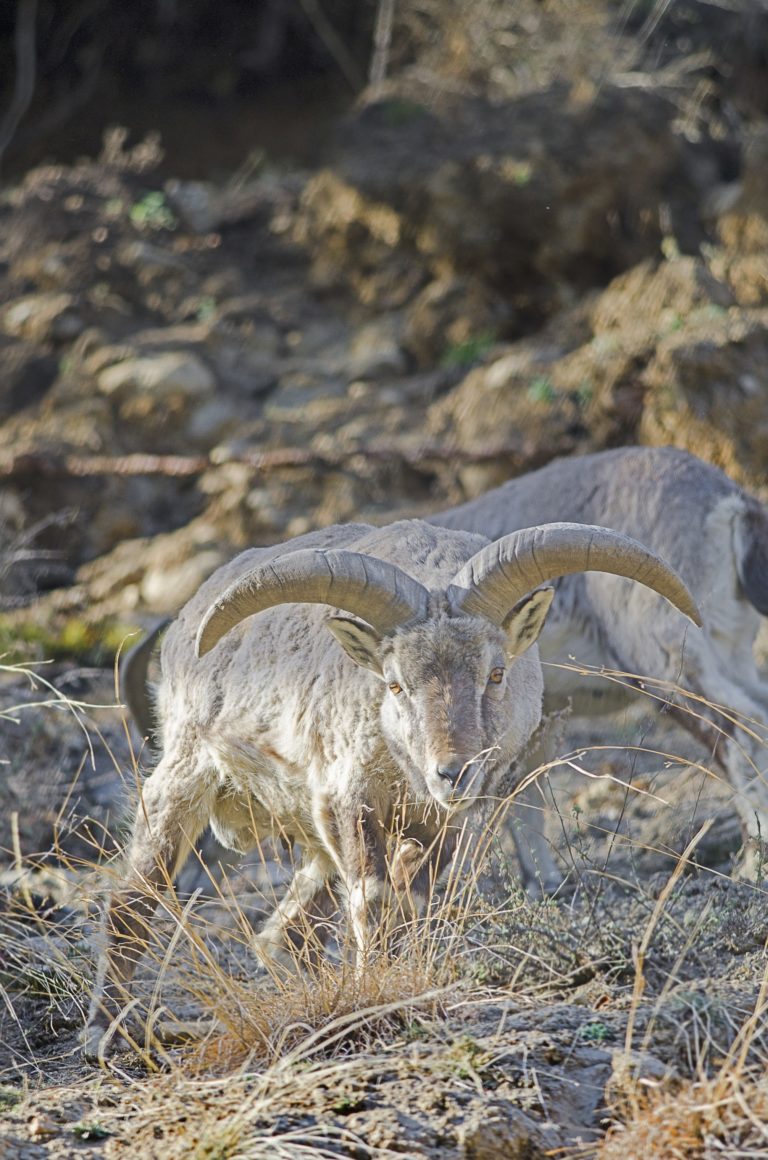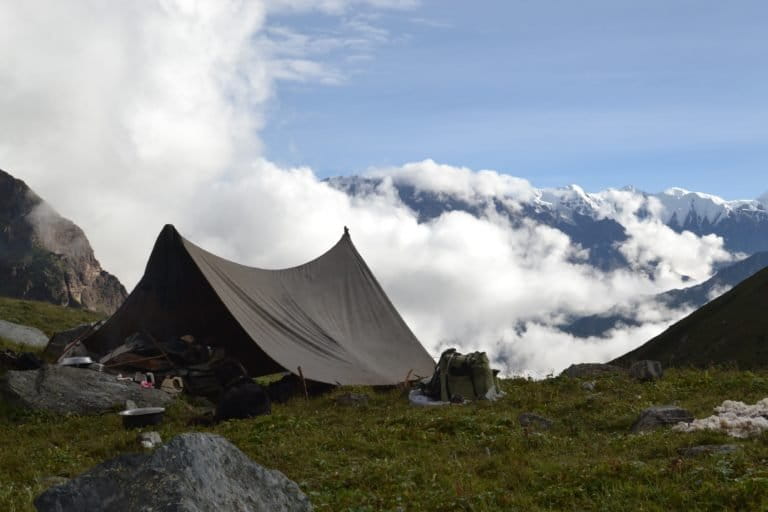- In the summer, nutritious grasses growing in Himalayan valleys and moderately rugged terrains far away from cliffs are ideal for foraging mountain ungulates such as blue sheep.
- A new study finds that pastoralists’ presence and their foraging livestock in these areas overlaps with blue sheep, pushing the sheep into more rugged areas. At the same time, they maintain a safe distance from predators and livestock.
- These areas are sub-optimal for foraging, which could affect their nutritional balance as they spend more energy to avoid livestock grazed areas.
- By providing training and incentives to pastoralists, some optimal foraging areas could be maintained livestock-free for the blue sheep.
Blue sheep, locally known as bharal, are wild mountain ungulates which are, in fact, more closely related to goats than sheep. They reside in the Himalayas and are the main prey base for endangered snow leopards in the region. During the summer-monsoon season, blue sheep graze on alpine grasses found in valleys where pastoralists also migrate to graze their livestock.
A new study by researchers from the Wildlife Institute of India has analysed resource use patterns of blue sheep in the presence of livestock in Johar valley in Uttarakhand. The study shows that while blue sheep forage in the same habitat after livestock arrival, they shift to grazing in more rugged terrain to avoid humans and livestock.
High-intensity areas predicted for blue sheep overlap 39 percent with the probability of the presence of livestock, according to the study.
“Since resources are limited and patchily distributed in the alpine regions, an overlap of 39 percent is an indication of a resource conflict,” said doctoral student Ankita Bhattacharya and lead author of the study. “Presence or overlap of livestock in these areas provides insights on managing pastoral practices in selected regions to aid conservation of blue sheep.”
For centuries, the alpine rangelands of Johar valley and other valleys have been used seasonally by agro-pastoral communities such as the Bhotiya and Gaddis for grazing their livestock, noted Bhattacharya and scientist Gopal S. Rawat, who is a co-author. These practices, known as transhumant pastoralism, were not a threat because of the low livestock population, said Bhattacharya, but over the past few decades, livestock holding has grown and overgrazing shows a decrease in grasses and increase of unpalatable species.

“In need of livelihood improvement, more and more numbers of livestock are increasing day by day causing overstocking and overgrazing,” explained Bhattacharya. “Overstocking is also an insurance against losses due to predation and unfavourable climatic conditions. Thus, degradation of habitat, substitution of optimal foraging patches with less nutritious patches, risk of predation as well as hunting are the major problems faced by the ungulates due to overstocking and overgrazing.”
Predicting blue sheep and livestock resource selection
The research team carried out field observations of blue sheep and livestock in 63 percent of their study area in Johar valley (elevation range of 1918–6727 metres), located in the upper catchment of the Gori river.
Studying animals in the Himalayas is challenging because of the harsh terrain, elusive nature and rarity of species, said Bhattacharya and co-author Nilanjan Chatterjee, who is also a doctoral student. Although recent studies have relied on radio-telemetry, which involves attaching a radio transmitter to animals and tracking their movement through radio signals, it is more suited to a smaller study area and has other limitations. Consequently, the team used a point-process framework to model the resource selection probability of blue sheep and livestock.
“This model estimates the species distribution focusing on the presence-only observed data and accordingly selects the number of pseudo-absence points required for the analysis,” explained Chatterjee. “Through this approach, we tried to model the intensity of the occurrence points using environmental factors.”

Livestock and blue sheep both preferred open vegetation, with the former in lower altitudes and valley floors and the latter in alpine meadows. Their results suggest that blue sheep tend to avoid optimal patches of grazing, usually in moderately rugged areas and valley floors, due to the presence of pastoralists and livestock and they maintain a distance of 600 to 1000 metres from cliffs — their escape terrain from disturbances such as predators and in this case livestock presence.
“An interesting behaviour of mountain ungulates like blue sheep is their strategy for predator avoidance,” Bhattacharya observed. “These animals have specialised limbs which help them climb steep slopes or cliffs in case of predation. These steep cliffs (slopes above 45 degrees) are termed as escape terrain.”
Read more:
Blue sheep shift to more rugged, less disturbed terrains to avoid livestock. The researchers believe these are sub-optimal foraging areas because nutritious grasses are patchily distributed and far away from cliffs.
“This shift affects the quality of grazing for blue sheep” because “nutritious grasses grow for a limited period in the summer monsoon season and are important for lactation and maintaining other physiological functions of the mountain ungulates,” said Bhattacharya and Bilal Habib, lead scientist and senior author of the study.
“Availing forage in the optimal patches requires less energy expenditure and easy availability of nutritious fodder, thus a natural choice,” they added.

Pastoralist communities key to maintaining biodiversity
The spatial map of the probable optimal resource-rich areas preferred by blue sheep can help manage rangelands and pastoral practices in the region. Bhattacharya highlights the importance of pastoralists’ traditional knowledge of alpine meadows and fauna, which can help greatly in monitoring biodiversity in Himalayan rangelands.
“Awareness, training and incentives for the pastoralists can help to use their knowledge to maintain a biodiversity information flow regarding mountain ungulates,” Bhattacharya said, adding that some of the optimal pastures can be avoided entirely for mountain ungulates to access exclusively. But this will “require incentives and active participation of the pastoral communities, local stakeholders, state forest departments and organisations studying wildlife conservation,” she acknowledged.
Subhash R. Lele, a Prof-Associate Chair at the University of Alberta, Canada, who was not connected with this research, said that the study is interesting and important for wildlife management. He also pointed out two issues, which could have an impact on management decisions.
First, he explained was that the method assumes that the resources at the random locations from the study area represent the resources blue sheep would have used if they were not differentiating between resources. “This assumption can be violated, for example, if the species under study exhibits grouping behaviour or if they have high fidelity to the area where they were born or many other mechanisms that have nothing to do with selection of the resources,” said Lele, suspecting that blue sheep are gregarious.
Second, while the study uses “relative risk” to determine how much the probability of selection by blue sheep has changed because of grazing by livestock, he said “absolute probability” can give a more accurate sense of the impact of grazing on blue sheep.
He explained with two examples: “In the first situation, probability of selection of a resource unit without grazing is 0.8 and with grazing, it is reduced to 0.4. The relative change due to grazing is of factor 2. Consider an alternative situation where the probability of selection without grazing is 0.1 and it is reduced to 0.05 with grazing. The relative change is of factor 2 again. However, from the management perspective, the first situation is likely to have a much more serious impact on the survival of the species than the second situation where the area was already quite bad and it became slightly worse due to grazing.”
This study can be tied with radio telemetry for better insights in more-detailed future studies on the ecology of blue sheep, said the researchers.
CITATION:
Bhattacharya, A., Chatterjee, N., Rawat, G. S., & Habib, B. (2020). Blue Sheep Resource Selection in Alpine Grasslands of a Western Himalayan Landscape–A Point Process Approach. Zoological Studies, 59(2020).
Banner image: Livestock grazing in the Johar Valley, Uttarakhand. Photo by Ankita Bhattacharya.
